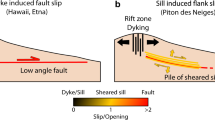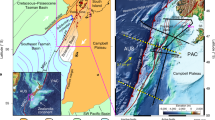Abstract
Stress transfer from a large earthquake may trigger subsequent earthquakes in nearby regions1,2,3. Such a mechanism has been suggested for a few isolated cases of magmatic intrusions and eruptions4,5,6, but has not been systematically demonstrated. An ongoing rifting episode, which began in 2005, along the Nubia–Arabia plate boundary provides a unique opportunity to test any such linkage. The intrusion of a 60-km-long magmatic dyke marked the beginning of the episode7,8,9,10,11,12 and, between June 2006 and July 2009, 12 more dykes were emplaced13. Here we use geodetic surveys and simple dislocation models to locate and quantify the extension that occurred during each event. We identify regions where tensile stress was increased (unclamped) by the previous dyke intrusions. Of the 12 events that followed the initial intrusion, nine dykes were observed to have at least half of their opening in regions unclamped by the previous events. We propose that the transfer of stress links the 13 dyke intrusion events. We suggest that the stress change that is induced by a new dyke is an important factor in determining the location of future events and could help improve volcanic hazard analysis.
This is a preview of subscription content, access via your institution
Access options
Subscribe to this journal
Receive 12 print issues and online access
$259.00 per year
only $21.58 per issue
Buy this article
- Purchase on Springer Link
- Instant access to full article PDF
Prices may be subject to local taxes which are calculated during checkout



Similar content being viewed by others
Change history
01 October 2010
In the version of this Letter originally published, the positions of several of the outlines of dyke openings in Figure 2 were incorrect. These errors have now been corrected in the HTML and PDF versions of the text.
References
Reasenberg, P. A. & Simpson, R. W. Response to regional seismicity to the static stress change produced by the Loma Prieta earthquake. Science 255, 1687–1690 (1992).
King, G. C. P., Stein, R. S. & Lin, J. Static stress changes and the triggering of earthquakes. Bull. Seismol. Soc. Am. 84, 935–953 (1994.).
Harris, R. A. & Simpson, R. W. In the shadow of 1857—the effect of the Great Ft. Tejon earthquake on subsequent earthquakes in southern California. Geophys. Res. Lett. 23, 229–232 (1996).
Walter, R. & Amelung, F. Volcano–earthquake interaction at Mauna Loa volcano, Hawaii. J. Geophys. Res. 111, B05204 (2006).
Amelung, F., Yun, S. H., Walter, T. R., Segall, P. & Kim, S. W. Stress control of deep rift intrusion at Mauna Loa volcano, Hawaii. Science 316, 1026–1030 (2007).
Calais, E. et al. Strain accommadation by slow slip and dyking in a youthful continental rift, East Africa. Nature 456, 783–787 (2008).
Wright, T. J. et al. Magma-maintained rift segmentation at continental rupture in the 2005 Afar dyking episode. Nature 442, 291–294 (2006).
Yirgu, G., Ayele, A. & Ayalew, D. Recent seismovolcanic crisis in northern Afar, Ethiopia. EOS Trans. AGU 87, 325–336 (2006).
Ayele, A. et al. The volcano-seismic crisis in Afar, Ethiopia, starting September 2005. Earth Planet. Sci. Lett. 255, 177–187 (2007).
Barisin, I., Leprince, S., Parsons, D. & Wright, T. Surface displacements in the September 2005 Afar rifting event from satellite image matching: Asymmetric uplift and faulting. Geophys. Res. Lett. 36, L07301 (2009).
Grandin, R. et al. September 2005 Manda Hararo–Dabbahu rifting event, Afar (Ethiopia): Constraints provided by geodetic data. Geophys. Res. Lett. 114, B08404 (2009).
Ayele, A. et al. September 2005 mega-dike emplacement in the Manda–Harraro nascent oceanic rift (Afar depression). Geophys. Res. Lett. 36, L20306 (2009).
Hamling, I. J. et al. Geodetic observations of the ongoing Dabbahu rifting episode: New dyke intrusions in 2006 and 2007. Geophys. J. Int. 178, 989–1003 (2009).
Hayward, N. J. & Ebinger, C. J. Variations in the along-axis segmentation of the Afar rift system. Tectonics 15, 244–257 (1996).
Rowland, J. V. et al. Fault growth at a nascent slow-spreading ridge: 2005 Dabbahu rifting episode, Afar. Geophys. J. Int. 171, 1226–1246 (2007).
Ebinger, C. et al. Capturing magma intrusion and faulting processes during continental rupture: Seismicity of the Dabbahu (Afar) rift. Geophys. J. Int. 174, 1138–1152 (2008).
Keir, D. et al. Evidence for focused magmatic accretion at segment centres from lateral dike injections captured beneath the Red Sea rift in Afar. Geology 37, 59–62 (2009).
Okada, Y. Internal deformation due to shear and tensile faults in a half-space. Bull. Seismol. Soc. Am. 82, 1018–1040 (1992).
Cauchy, A. L. Recherches sur l’Équilibre et le Mouvement Intérieur des Corps Solides ou Fluides, Élastiques ou non Élastiques. Bull. Soc. Philomath. 2, 300–304 (1823).
Buck, W. R., Einarsson, P. & Brandsdóttir, B. Tectonic stress and magma chamber size as controls on dike propagation: Constrints from the 1975–1984 Krafla rifting episode. J. Geophys. Res. 111, B12404 (2006).
Desissa, M. et al. A magnetotelluric study of continental lithosphere in the final stages of break-up: Afar, Ethiopia. In IAGA Assembly, Hungary, no. 106-TUE-O1345-1158 in I06 (2009).
Stein, R. S. The role of stress transfer in earthquake occurrence. Nature 402, 605–609 (1999).
Watanabe, T., Masuyama, T., Nagaoka, K. & Tahara, T. Analog experiments on magma-filled cracks: Competition between external stresses and internal pressure. Earth Planet. Space 54, 1247–1261 (2002).
Nooner, S. L. et al. Post-rifting relaxation in the Afar region, Ethiopia. Geophys. Res. Lett. 36, L21308 (2009).
Rosen, P. A., Hensley, S., Peltzer, G. & Simons, M. Updated repeat orbit interferometry package released. EOS Trans. AGU 85, 47 (2004).
Farr, T. & Kobrick, M. Shuttle radar topography mission produces a wealth of data. EOS Trans. AGU 81, 583–585 (2000).
Goldstein, R. M. & Werner, C. L. Radar interferogram filtering for geophysical applications. Geophys. Res. Lett. 25, 4035–4038 (1998).
Goldstein, R. M., Zebker, H. A. & Werner, C. L. Satellite radar interferometry: Two-dimensional phase unwrapping. Radio Sci. 23, 713–720 (1988).
Okada, Y. Surface deformation due to shear and tensile faults in a half-space. Bull. Seismol. Soc. Am. 75, 1135–1154 (1985).
Wright, T. J., Lu, Z. & Wicks, C. Constraining the slip distribution and fault geometry of the MW 7.9, 3 November 2002, Denali fault earthquake with interferometric synthetic aperture radar and global positioning system data. Bull. Seismol. Soc. Am. 94, 175–189 (2004).
Acknowledgements
We would like to thank the Geophysical Observatory of Addis Ababa University, the Afar Regional government and the Ethiopian Ministries of Capacity Building, and of Mines and Energy for their help and support. Thanks to J. Cann, G. Houseman, J. Neuberg and R. Buck for discussions and to C. Ebinger for help with GPS data acquisition and funding support. Our work is supported by NERC grants NE/D008611/1, NE/D01039X/1 and NE/E007414/1, NSF grants EAR-0635789 and EAR-0613651, a NERC-COMET studentship to I.J.H., an Exxon-Mobil fellowship to L.B. and a Royal Society University Research Fellowship to T.J.W. Radar data is from the European Space Agency under project C1P-3435.
Author information
Authors and Affiliations
Contributions
I.J.H. and T.J.W. planned and processed the InSAR data. E.C., L.B. and E.L. collected and processed GPS data. I.J.H. carried out the elastic modelling and wrote the paper with contributions from all the co-authors.
Corresponding author
Ethics declarations
Competing interests
The authors declare no competing financial interests.
Supplementary information
Supplementary Information
Supplementary Information (PDF 1289 kb)
Rights and permissions
About this article
Cite this article
Hamling, I., Wright, T., Calais, E. et al. Stress transfer between thirteen successive dyke intrusions in Ethiopia. Nature Geosci 3, 713–717 (2010). https://doi.org/10.1038/ngeo967
Received:
Accepted:
Published:
Issue Date:
DOI: https://doi.org/10.1038/ngeo967
This article is cited by
-
The centenary of IAVCEI 1919–2019 and beyond: The people, places, and things of volcano geodesy
Bulletin of Volcanology (2022)
-
Volcanic activity and hazard in the East African Rift Zone
Nature Communications (2021)
-
Synthesis of global satellite observations of magmatic and volcanic deformation: implications for volcano monitoring & the lateral extent of magmatic domains
Journal of Applied Volcanology (2018)
-
Large-scale dynamic triggering of shallow slow slip enhanced by overlying sedimentary wedge
Nature Geoscience (2017)
-
Birth of two volcanic islands in the southern Red Sea
Nature Communications (2015)



